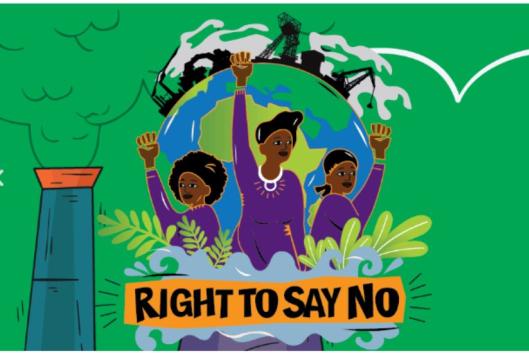A report by Edwin C. Perry, Cheryl Potgieter and Urmilla Bob,(1) highlights the links between environmental conflicts and women. The authors join to the growing attention put by women’s movements, non-governmental organizations (NGOs) and researchers, among others,on violence against women as well as on the need to examine its links to situations of conflicts
The report states that violence against women “takes place more frequently during periods of conflict, especially when physical violence characterises the type of conflict experienced and when the conflict occurs in societies that tend to be patriarchal. Women’s vulnerability increases significantly during periods of violence, and environmental conflicts are no exception. This aspect is particularly important given that environmental conflicts often result in displacement, migration and/or refugees.
While studies have demonstrated that gender-based violence is a characteristic of environmental conflicts (2), there are very little data available on the actual and perceived spatial distribution and understanding of gender-based violence and vulnerability related to environmental conflicts.
The sources and meanings of how women themselves perceive the environment and the conflict are critical to understanding gender and violence. The main sources of information about women’s vulnerability in environmental conflict situations are based primarily on official (usually police) statistics, victim surveys and a series of estimates by organisations working with survivors of violence. It isimportant to note that there is consensus that in most cases violence against women is not reported to official sources, including the police. Furthermore, victim surveys and information from the survivors of violence tend to be limited to specific case studies and/or anecdotal experiences.
There are also political consequences in relation to women’s increased vulnerability. While fear of victimisation restricts women’s lives and causes distress, additionally, particularly when conflicts result in extreme violence, vulnerable community members often retreat from public spaces. Given the patriarchal nature of societies, women’s participation in the public sphere is generally limited in any event. This retreat often results in women’s experiences and issues not being raised when the impacts of the environmental conflict/s are being discussed and intervention strategies are being developed.
There is acceptance that poverty and environmental degradation (an important aspect of several types of environmental conflicts) have disproportionate impacts on African women (especially those who reside in rural areas). The feminisation of poverty is well documented. However, there is a dearth of studies that examine the feminisation of environmental conflicts in relation to the disproportionate burdens and increased vulnerability women face as a result of environmental conflicts. Their vulnerability is also directly linked to the fact that although women constitute more than half of the population and provide the majority of the food supply in developing countries, they have limited access, ownership and co-ownership to land and natural resources. In Swaziland, women’s contribution to labour and management in food production has been put between 60 and 80%.” (3)
Connected to the direct impact of environmental conflicts on women’s lives, especially in poor communities, the authors explain how, following the violence in Liberia during the recent civil war, “women were less concerned about redress and reparations for sexual violence but more concerned about the loss of their livelihoods as well as their ability to access resources such as safe water and services such as education and health care.”(4)
In rural Africa, the report reflects on situations where women have economic dependence on men, even reinforced by cultural traditions and religious practices that dictate women’s relationships and roles in societies as well as the relationships to resources, especially land. They explain that “extensive research shows that in comparison with men, women are generally at a disadvantage in terms of control and access to resources, including land.” (5)
Yet, women are key environmental caretakers. Their vast knowledge about the ecosystem that constitutes their livelihood is key to guarantee the future of local communities and the forests and biomes they depend on. To conserve Nature well has direct links to women and their access to all that Nature offers such as water, firewood, medicinal plants, wild foods and agricultural land. As the authors of the report explain: “Environmental conflicts have often resulted in restricted access to or degradation of these vital resources.”
For the impoverished sectors – who, agreeing with the authors, are often poor women and children – “the cost of environmental conflicts is greater, given restricted access to resources and opportunities as well as fewer available mechanisms – such as the ability to move, or resources to increase protection – to cushion the effects of being victimised.”
Acknowledging the role of women in the conservation of forests and Nature in general as well as their vulnerability to restricted and limited resource availability raises awareness about the link between them and environmental conflicts. Indeed, it adds to the need of building an ecological and integrated vision that leads the way for a change in our societies.
(1) “Environmental conflicts and women’s vulnerability in Africa”, Edwin C. Perry, Cheryl Potgieter and Urmilla Bob, in African Journal on Conflict Resolution, Special Issue on Environment and Conflict, Volume 10 No. 2, 2010,
http://www.ajol.info/index.
(2) See for example Brocklesby and Hinshelwood 2001;Fred-Mensah 2003; Ogra 2008; Veuthey and Gerber 2009.
(3) Mkhabela (2006:67)
(4) Pillay (2009:98)
(5) Agarwal 1996, focusing on India; Cross and Hornby2002, focusing on South Africa; Fred-Mensah 2003, focusing on the Ghana-Togoborder; Rao 2006, focusing on India.
